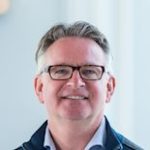Nico Verdonschot, Prof. Dr. Ir.
About me
In 1988 I started my master thesis in Nijmegen at the Orthopaedic Research Laboratory (ORL). Mid 1989 I received my M.Sc. in (Bio-)Mechanical Engineering from the University of Twente. After my graduation I stayed at the ORL as Junior Researcher and performed various kinds of projects focusing on testing of orthopaedic implants. Most projects were funded by the Orthopaedic Industry which gradually led to an extensive network of R&D departments from small to large international orthopaedic companies. The publications of these projects resulted in my Ph.D. degree in 1995 on a thesis entitled “Biomechanical Failure Scenarios for Cemented Total Hip Replacement“. Subsequently I was promoted to Assistant Professor and was appointed to be Director of ‘Pre-clinical Testing of Joint Implants’. In 2003 I was further promoted to Associate Professor.
In Nijmegen, our research concerns computer simulations of implants, fracture prediction of weakened bones and musculoskeletal modelling. Our group utilizes computer modelling techniques in combination with cadaveric testing, animal research and clinical studies in order to optimize diagnostic and evaluation tools for orthopaedic patients. We work with researchers, clinicians and orthopaedic companies to optimize the functionality and longevity of orthopaedic implants such as knee and hip prostheses. Furthermore, we focus on the calculation of bone strength for patients that have osteoporosis or metastatic lesions. Most of our research is embedded in the Research Institute for Medical Innovation, within the theme ‘Reconstructive and regenerative medicine‘.
Since October 2007 I have a part-time appointment (1 day per week) as Professor in ‘Implant Biomechanics’ at the University of Twente, department of Biomechanical Engineering. In collaboration with my clinical colleagues at the Radboudumc, I have set up a research line in Twente that relates to clinical biomechanics of the Musculo-Skeletal system. We are creating an ICT-based patient-specific surgical navigation system that helps a surgeon safely reaching the optimal functional result for the patient and that will be a user friendly training facility for surgeons. This research was funded by the EU project TLEMsafe between March 2010 and August 2014.
I was awarded a ‘European Research Council – Advanced Grant’ in December 2012, entitled ‘Biomechanical Diagnostic, Pre-Planning and Outcome Tools to improve Musculoskeletal Surgery’, acronym BioMechTools. In Nijmegen this five year grant, starting in May 2013, enabled us to expand our modelling efforts. We have generated patient specific models that are fed with innovative dynamic imaging techniques.
In February 2014 I was appointed full Professor in ‘Biomechanical Diagnostics and Evaluation Methods in Orthopaedics’ at the Radboud university medical center. Since September 1st 2015, I’m chair of the ORL. In March 2017 I started as a visiting professor at the Politecnico di Milano (Italy) where I am lecturing Computer modelling in Orthopaedic Biomechanics. From February 1st 2018, till 2022 I was Scientific Director of the TechMed Centre at Twente University. In principle I work in Twente for 3 days a week.

- Nico.Verdonschot@radboudumc.nl
- T: +31 (0)24 36 13918 (secretary)
Research Impression
I focused on setting up a strong research line concerning computer simulations of implants, fracture prediction of weakened bones and musculoskeletal modeling. This research line is multi-dimensional, including finite element computer simulations, experimental testing, in-vivo kinematics and musculoskeletal modeling. Currently I am coordinator of an EU-STREP (FP7) project which is aimed at predicting the functional effect of tumor surgery on the musculoskeletal system by using musculoskeletal models (see www.tlemsafe.eu ). In December 2012 I obtained a five year ERC Advance Grant which allows us to expand our work on personalized modeling of the lower extremity, see our research ‘ERC BioMechTools‘.
Clinical areas in which our group has made major contributions are: functional analysis of knee and hip (revision) patients, ligament reconstruction, computer navigation, clinical/functional effects of long bone fractures, treatment of cartilage and meniscus defects, reconstruction of bony defects around implants, fracture fixation devices, evaluation of biomaterials, improving imaging based orthopedic surgery, designing implants and developing instruments for minimal invasive surgery.
In the computer modeling area our group has contributed on topics as: the effect of muscle loads on the survival of implants, the simulation of peri-prosthetic bone remodeling, the simulation of the micro-mechanics of the cement-bone interface, the time-dependent creep and fatigue behavior of bone cement, the ingrowth process of bone into coated implants, the fracture simulation of bones that are weakened due to cancer, the kinematic behavior of knee prostheses and the sensitivity of musculoskeletal models to small changes in muscle parameters.
Publications
- PubMed
- My Thesis: Biomechanical Failure Scenarios for Cemented Total Hip Replacement
- NARCIS: National Academic Research and Collaborations Information System of The Netherlands
- Research Information System of the University of Twente
- ResearcherID: H-8104-2014 Verdonschot N.J.J.
- Scopus Author ID: 7006362754 – Verdonschot, Nico J.J.
- ORCID ID: 0000-0002-7531-6523 (no entries yet)
- researchgate.net
- search Google Scholar for ‘N Verdonschot’